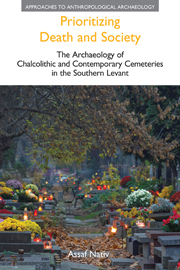 Prioritizing Death and Society
Prioritizing Death and Society Book contents
- Frontmatter
- Dedication
- Contents
- List of figures
- List of tables
- Acknowledgements
- Part I Introduction
- Part II Chalcolithic cemeteries
- Part III Contemporary cemeteries
- 10 An archaeology of us
- 11 The raw materials: from matt to lustre, from grey to colour
- 12 Tombstone morphology: communal trajectories
- 13 Tombstone elaboration: personal expressions
- 14 Spatial patterns: between institutional policy and interpersonal spontaneity
- 15 Intersecting discourses
- Part IV Conclusion
- Appendix: Gazetteers of cemeteries
- Notes
- Bibliography
- Index
11 - The raw materials: from matt to lustre, from grey to colour
from Part III - Contemporary cemeteries
- Frontmatter
- Dedication
- Contents
- List of figures
- List of tables
- Acknowledgements
- Part I Introduction
- Part II Chalcolithic cemeteries
- Part III Contemporary cemeteries
- 10 An archaeology of us
- 11 The raw materials: from matt to lustre, from grey to colour
- 12 Tombstone morphology: communal trajectories
- 13 Tombstone elaboration: personal expressions
- 14 Spatial patterns: between institutional policy and interpersonal spontaneity
- 15 Intersecting discourses
- Part IV Conclusion
- Appendix: Gazetteers of cemeteries
- Notes
- Bibliography
- Index
Summary
Among the raw materials from which tombstones are constructed, four recurring types were readily distinguished, each with its own unique visual effect and texture:
cement — relatively rough-textured and grey, although it appears that at least sometimes it was white-washed;
limestone — often polished, producing a smooth white to beige surface;
Turkish marble — always polished, producing a highly lustrous pale blue to greyish surface;
granite — always polished, producing a highly lustrous, dark grey to black surface.
Because these categories differ considerably from one another, the assignment to either one or sometimes two of them by direct observation was fairly easy. Most tombstones were made of a single material, sometimes accompanied by minor additions such as narrow bands or small plaques. Under these circumstances, the tombstone was labelled as consisting of the dominant raw material alone.
Alongside these, however, one also notes the presence of hybrid tombstones that combine two distinct materials in roughly similar proportions. There are two common types of these hybrid tombstones: one combines cement and limestone, and the other combines granite and either limestone or Turkish marble. The first was observed mostly in the cemeteries of Ma'abarot, Trumpeldor and Netzah. While at face value these may be considered as composite types, there is good reason to suspect that they represent episodes of repair and change. Generally speaking, cement is the least durable of the materials used for tombstone construction, prone to friability or porosity.
- Type
- Chapter
- Information
- Prioritizing Death and SocietyThe Archaeology of Chalcolithic and Contemporary Cemeteries in the Southern Levant, pp. 148 - 155Publisher: Acumen PublishingPrint publication year: 2013


